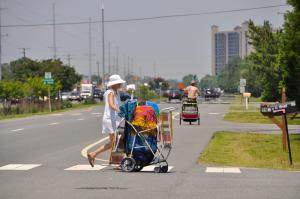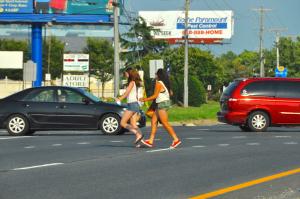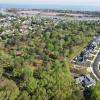DelDOT: Funding limited for Sussex roads
When it comes to transportation, Sussex County Council got a huge dose of reality at its July 16 meeting.
Drew Boyce, director of Delaware Department of Transportation planning, told council that because of limited funding, many Sussex projects are still on the back burner.
In the fiscal 2014 budget, only $170 million in state funding is available for projects; $342 million is used for operating expenses. And the pot of federal money, which now comprises more than half of all DelDOT capital money, has limited uses in Sussex County.
Councilwoman Joan Deaver, D-Rehoboth Beach, had requested a DelDOT presentation on how the agency prioritizes projects. Boyce eventually did talk about the process, but he also schooled council on DelDOT's finances.
Deaver said she still does not have a good understanding how DelDOT allocates funds for projects, but she said she will continue to pursue answers, especially when it comes to safety issues along Route 1. “I still can't see why DelDOT can't put up lights along Route 1 right now,” she said. “And there is no way that Route 24 needed new paving; it needs to be widened.”
She is referring to lighting along the roadway and not traffic signals.
Deaver said future prospects for Sussex road work are not good. “It looks like Sussex is going to get less money than ever before, but I don't understand that because we are the county where the growth is taking place.”
Federal funds are limited in Sussex
DelDOT is still working to get its long-standing debt service paid off. More than 30 percent of the operating budget – $112 million – goes to paying down debt. Boyce said debt service has been reduced from $1.2 billion two years ago to $930 million this year.
Boyce said the budget includes more than $512 million in revenue. He said except for DMV fees, all sources – including tolls and taxes – are flat.
Because of limited state funding, most DelDOT capital projects rely on federal funds; more than half of the money for capital projects comes from federal sources, but that money comes with restrictions.
“Federal funding comes with a lot of strings like where the money can be spent and what road type. It's not available for all roads,” he said. “Sussex County has limitations because of its rural nature.”
About $1.3 million is available in Sussex County compared to $13 million in New Castle County. Another $11 million in federal money is available for the entire state to help fund road safety projects, Boyce said.
He said most of the flexible federal funding is currently being spent on the Route 26 project. “It's at the point where we can only do a couple of big projects at a time in Sussex County until we get a better handle on state funds with more revenue,” he said.
The only roads that fall under federal funding in Sussex are routes 1, 13, 113 and 404/9; local roads do not qualify.
DelDOT officials have tapped into federal toll credits, a new source of federal funds. Under the program, the state is reimbursed for every dollar of state money used for improvements on toll roads. Boyce said the state will receive $130 million in one-time reimbursements that can be used as state-match money to leverage additional federal funding.
DelDOT faces other financial issues
Boyce said DART bus service is subsidized to the tune of about $90 million each year. Because of that, he said, DelDOT officials are taking a serious look at the bus service. He said one area of concern is paratransit service, which contributes 8 percent of revenue but consumes 46 percent of the DART operating budget. Fixed-route buses provide more than 80 percent of DART revenue.
Paratransit service is a low-cost, curb-to-curb public transportation service for people with disabilities who are unable to use regular DART buses.
“It's a tough balance. We know it has to be subsidized, but at what level?” he asked.
The Federal Transit Authority provides about $20 million annually – which is more than DART revenue – to purchase equipment and buses.
Another looming issue facing DelDOT is compliance with the federal Americans With Disabilities Act in sidewalk construction. Boyce said about 50 percent of sidewalks under state jurisdiction are not compliant and must be retrofitted over the next few years at a price tag of $500 million.
In addition, maintaining current transportation infrastructure has to be included in the budget. Boyce said the millions needed to keep or get infrastructure in a state of good repair competes with capital projects.
Setting project priorities is complex
Boyce admitted that the current process for prioritizing projects is at times dysfunctional, and DelDOT is moving toward a new process. Under any process, he said, safety is always the main concern.
In 2006, Boyce said, budget restraints hit DelDOT hard and two-thirds of all capital projects were cut or delayed. It's been catch up ever since. Sidewalks and crosswalks work on Route 1 – one of the delayed projects in the Cape Region – is scheduled to begin in the spring of 2014.
“We are looking at different ways to prioritize projects. Any process is complex,” he said. “We are getting away from back-room sessions to more transparency because that's what the public wants.”
A new computerized system would allow DelDOT staff to rate projects against one another based on criteria such as cost, safety, economic development and vehicular capacity. “The missing link has always been how to compare projects,” he said.
Cole: Crossing on Route 1 is illogical
Sussex County Councilman George Cole, R-Ocean View, brought up one of his favorite topics during the DelDOT presentation – crosswalks along Route 1 in the Bethany Beach and South Bethany areas.
There are several crosswalks not at traffic signals across four lanes of the highway where the speed limit is 55 mph. “It seems so illogical to allow pedestrians to enter into traffic in this unsafe situation. Who engineers this stuff?” Cole asked.
In all, there are 31 Route 1 crossings between the Indian River Inlet bridge and South Bethany. Of those, six crossings are at traffic signals and 25 are not at signals. Two of the crossings are in 55 mph zones while the rest are in 35 mph speed zones.
There are also several crosswalks in Dewey Beach not controlled by traffic signals that are also dangerous, Cole said.
Cole said motorists and pedestrians are confused over who has the right of way and who is supposed to yield. Under Delaware law vehicles are supposed to yield to pedestrians in crosswalks.
He said if DelDOT has put a lot of thought into the situation than the agency needs to get some different people to think about it. “Someone needs to come back with a common-sense solution,” he said.
“Our goal is to get pedestrians to cross at signals, but we are dealing with human nature,” said Drew Boyce, DelDOT director of planning.
Councilman Vance Phillips, R-Laurel, agreed with Cole. “Giving pedestrians the right-of-way to cross on high-speed roads doesn't make sense,” he said.
He said the practice needs to be changed even if it requires rewriting state law.
MAJOR SOURCES OF DELDOT REVENUE
Tolls – $169 million
DMV fees – $154 million
Motor fuel tax – $118 million
* Escheat – $33 million
Transit – $19 million
* It's money collected by the state from abandoned property. The Office of Management and Budget provides allotments to various state departments in their budgets.

























































